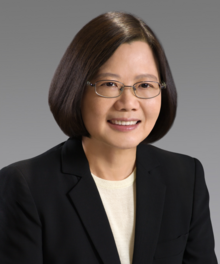Chairman of the National Government
| President of the Republic of China 中華民國總統 Zhōnghuá Mínguó Zǒngtǒng |
|
|---|---|

Presidential Seal
|
|

Presidential Standard of the Republic of China
|
|
| Style |
Madame/Mr. President (總統女士/先生) (Informal) Her/His Excellency (閣下) (In international correspondence) |
| Residence | Yonghe Residence |
| Seat |
Presidential Palace, Nanking (1947-1949) Presidential Office Building, Taipei (1949-present) |
| Appointer | Direct election |
| Term length | Two consecutive 4-year terms Section 6 of Article 2 of the Additional Articles of the Constitution of the Republic of China |
| Constituting instrument | Constitution of the Republic of China |
| Formation | 1 January 1912 as the Provisional President 10 October 1913 as the President (Peiyang Government) 10 October 1928 as the Chairman of the Nationalist Government 5 August 1948 as the President of the ROC |
| First holder |
Sun Yat-sen as the first Provisional President in 1912 Chiang Kai-shek as the first President under the 1947 Constitution |
| Deputy | Vice President of the Republic of China |
| Salary |
NT$6,428,282 annually (~US$200,000) |
| Website |
english |
| President of the Republic of China |
|||||||||||||||||||||||||||
| Traditional Chinese | |||||||||||||||||||||||||||
|---|---|---|---|---|---|---|---|---|---|---|---|---|---|---|---|---|---|---|---|---|---|---|---|---|---|---|---|
| Simplified Chinese | |||||||||||||||||||||||||||
|
|||||||||||||||||||||||||||
| Transcriptions | |
|---|---|
| Standard Mandarin | |
| Hanyu Pinyin | Zhōnghuá Mínguó Zǒngtǒng |
| Bopomofo | ㄓㄨㄥ ㄏㄨㄚˊ ㄇㄧㄣˊ ㄍㄨㄛˊ ㄗㄨㄥˇ ㄊㄨㄥˇ |
| Gwoyeu Romatzyh | Jonghwa Min'gwo Tzoongtoong |
| Wade–Giles | Chung¹-hua² Min²-kuo² Tsung³-t'ung³ |
| Tongyong Pinyin | Jhonghuá Mínguó Zǒngtǒng |
| MPS2 | Jūng-huá Mín-guó Tzǔng-tǔng |
| Hakka | |
| Romanization | Chûng-fà Mìn-koet Chúng-thúng |
| Southern Min | |
| Hokkien POJ | Tiong-hôa Bîn-kok Chóng-thóng |
| Tâi-lô | Tiong-hûa Bîn-kok Tsóng-thóng |
The President of the Republic of China (Chinese: 中華民國總統; pinyin: Zhōnghuá Mínguó Zǒngtǒng) is the head of state of the Republic of China (ROC) and commander-in-chief of the Republic of China Armed Forces. The ROC was founded in 1912, to govern all of China; however, after the ROC lost control of mainland China, the government of the Republic of China relocated to Taiwan in the late 1940s. The existing office of President was created in 1948 under the 1947 Constitution of the Republic of China. The first president under the constitution was Chiang Kai-shek. Tsai Ing-wen succeeded Ma Ying-jeou on 20 May 2016 as the first female president in the nation's history.
After the outbreak of the Wuchang Uprising against Qing rule in 1911, the revolutionaries elected Sun Yat-sen as the "provisional president" (臨時大總統) of the transitional government, with the Republic of China officially established on January 1, 1912. But Sun soon resigned from the provisional presidency in favor of Yuan Shikai, who assumed the title "Great President" (大總統) in March 1912. Yuan induced the Last Emperor to abdicate, ending thousands of years of imperial rule in China. The 1913 Constitution called for a strong presidential system with notable checks on the president by the National Assembly. However, Yuan soon began to assert dictatorial power, ignoring the National Assembly and later abolishing it altogether. In 1915, Yuan proclaimed himself Emperor of China in a largely unpopular move and was forced to retract his declaration shortly before his death in 1916.
...
Wikipedia

